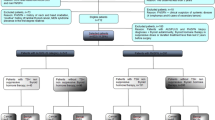Abstract
Three hundred and fifty-five patients treated for hyperthyroidism by subtotal thyroidectomy have been followed for up to 11 years (mean 5 yr) by a computer-assisted follow-up register (WAFUR). The system is based on a central hospital clinic with patients being reviewed regularly by their general practitioners over a wide geographic area and blood samples being mailed to the hospital. After allowing for 50 patients who were lost to follow-up and 48 recalled because of hypothyroidism, 1,379 thyroid function tests were evaluated in the remaining 257 patients. Forty-three of 132 surgically treated patients and 81 of 125 surgically treated patients on replacement T4 therapy had normal TSH levels throughout the follow-up period. The other patients all had at least 1 elevated TSH level. In patients not receiving T4 therapy, 47% of tests with a normal serum T4 had elevation of TSH. In patients receiving thyroxine, 46% of tests with normal TSH showed a rise in T4. It is concluded that this computer-assisted thyroid follow-up system is reliable and cost-effective. Further modification is required to identify patients lost to follow-up, to improve the diagnostic accuracy of the thyroid function tests, and to define the pathophysiological significance of minor abnormalities in T4 and TSH in otherwise euthyroid patients.
Résumé
Trois cent cinquante-cinq malades traités pour hyperthyroïdisme par thyroïdectomie subtotale ont été suivis jusqu'à 11 ans (5 ans en moyenne) après l'intervention en employant un système d'enregistrement sur ordinateur. Ce système repose sur une unité centrale de consultation hospitalière à qui les médecins de famille d'une large région géographique adressent les prélèvements sanguins. C'est ainsi que 1,379 tests fonctionnels thyroïdiens furent pratiqués chez 257 sujets, 50 autres malades ayant été perdus de vue et 48 traités pour hypothyroïdie. Quarante-trois des 132 sujets traités chirurgicalement et 81 des 125 opérés et traités par thyroxine ont montré des niveaux normaux de TSH pendant toute la période postopératoire. Les autres présentèrent au moins une fois un taux anormalement élevé de TSH. Quarante-sept pour cent des tests avec un taux normal de T4 avaient un taux élevé de TSH chez les opérés qui ne recevaient pas de T4. Chez les sujets qui recevaient de la thyroxine 46% d'entre eux qui présentaient un taux normal de TSH accusaient une élévation de T4. On peut conclure de cette étude que le système de contrôle proposé par les auteurs est valable et de coût satisfaisant. Des modifications sont cependant à envisager de façon à réduire le nombre des malades qui échappent au contrôle, de manière à améliorer la précision diagnostique des tests fonctionnels thyroïdiens et à définir la signification physiopathologique des anomalies mineures des taux de T4 et TSH chez les sujets euthyroïdiens.
Resumen
Trescientos cincuenta y cinco pacientes hipertiroideos tratados con tiroidectomía subtotal han sido seguidos hasta por 11 años (promedio 5 años) mediante un registre de seguimiento computadorizado. El sistema esta basado en una consulta hospitalaria central; los pacientes son revisados regularmente por sus médicos generales en una amplia área geográfica y las muestras sanguíneas son enviadas al hospital. Cincuenta pacientes desaparecieron del seguimiento y 48 desarrollaron hipotiroidismo; 1379 pruebas de función tiroidea fueron evaluadas en los 257 pacientes resultantes. Cuarenta y tres de 132 pacientes tratados quirúrgicamente y 81 de 125 tratados quirúrgicamente y manejados con medicación a base de T4 exhibieron niveles normales de TSH a través de la totalidad del seguimiento. El resto de los pacientes presentó por lo menos en una ocasión un nivel elevado de TSH. Cuarenta y siete por ciento de las pruebas con nivel normal de T4 sérico presentó elevación de TSH en los pacientes que no recibian terapia con T4. En los pacientes que recibían tiroxina, el 46% de las pruebas con TSH normal exhibió elevación de T4. Se puede concluír que este tipo de seguimiento computadorizado es confiable y de buen costobeneficio. Se requiere su modificación con el fin de identificar los pacientes que se pierden en el seguimiento, de mejorar la precision diagnóstica de las pruebas de función tiroidea y de definir la significación patofisiológica de anormalidades menores de T4 y de TSH en pacientes por lo demás eutiroideos.
Similar content being viewed by others
References
Lazarus, J.H., Wade, J.S.H.: The role of surgery in the management of thyrotoxicosis. In Endocrine Surgery, Butterworths International Medical Reviews Surgery 2, I.D.A. Johnston, N.W. Thompson, editors. London, Butterworths, 1983, pp. 1–13
Hedley, A.J., Flemming, C., Chesters, M.I., Michie, W., Crooks, J.: The surgical treatment of thyrotoxicosis. Br. Med. J.1:218, 1970
Lazarus, J.H.: Follow-up of thyroid disease: 3 years' experience of an automated system. Health Trends10:66, 1978
Challand, G.S., Ratcliffe, W.A., Ratcliffe, J.G.: Semi-automated radioimmunoassay for total serum thyroxine and tri-iodothyronine. Clin. Chim. Acta60:25, 1975
Tunbridge, W.M.G., Evered, D.C., Hall, R., Appleton, D., Brewis, M., Clark, F., Grimley Evans, J., Young, E., Bird, T., Smith, P.A.: The spectrum of thyroid disease in a community: The Wickham survey. Clin. Endocrinol.7:481, 1977
Jones, S.J., Curtis, B., Hedley, A.J., Allison, S.P., Woolfson, A.M.J., Steele, R., Bewsher, P.D., Weir, R.D.: Do we need thyroid follow-up registers? Lancet1:1229, 1982
Barker, D.J.P., Bishop, J.M.: Computer-based screening system for patients at risk of hypothyroidism. Lancet2:835, 1969
Hedley, A.J., Scott, A.M., Debenham, G.: A computer-assisted follow-up register. Methods Inf. Med.8:67, 1969
Weeks, I., Sturgess, M., Siddle, K., Jones, M.K., Woodhead, J.S.: A high sensitivity immunochemiluminometric assay for human thyrotropin. Clin. Endocrinol.20:489, 1984
Pearce, C.J., Himsworth, R.L.: Total and free thyroid hormone concentrations in patients receiving maintenance replacement treatment with thyroxine. Br. Med. J.288:693, 1984
Jennings, P.E., O'Malley, B.P., Griffin, K.E., Northover, B., Rosenthal, F.D.: Relevance of increased serum thyroxine concentrations associated with normal serum tri-iodothyronine values in hypothyroid patients receiving thyroxine: A case for “tissue thyrotoxicosis.” Br. Med. J.289:1645, 1984
Barnett, O.G.: The application of computer-based, medical record systems in ambulatory practice. N. Engl. J. Med.310:1643, 1984
Author information
Authors and Affiliations
Rights and permissions
About this article
Cite this article
Davies, P.D.O., Lazarus, J.H. & Wheeler, M.H. A computer-assisted thyroid follow-up system. World J. Surg. 10, 681–685 (1986). https://doi.org/10.1007/BF01655556
Issue Date:
DOI: https://doi.org/10.1007/BF01655556




